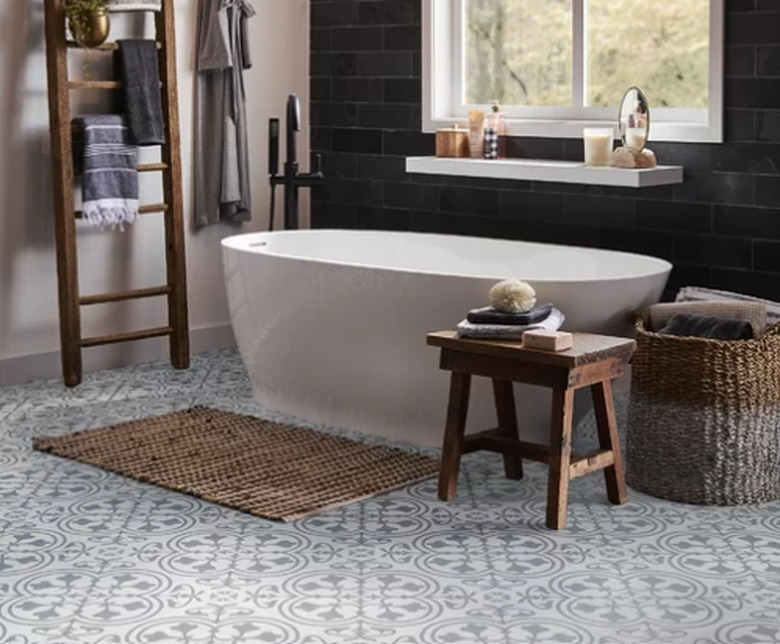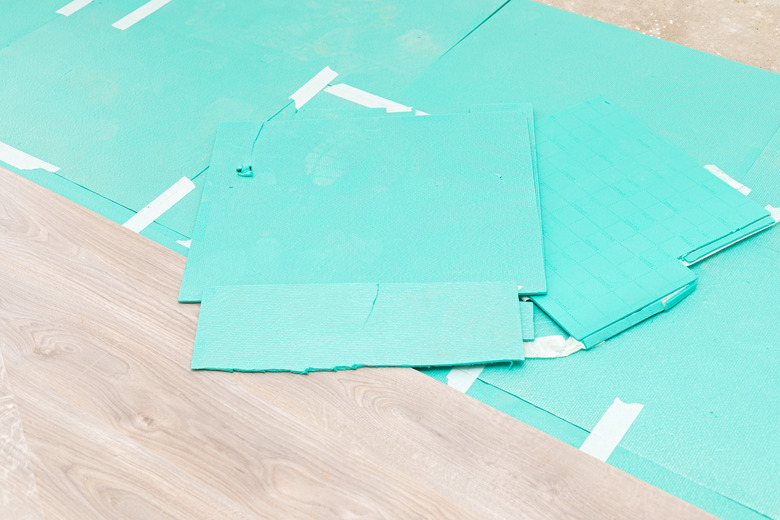How To Remove Vinyl Flooring
Vinyl flooring may have begun as an accidental discovery, but it has since evolved into an affordable home improvement flooring option thanks to its waterproof durability and easy installation. Is removing a vinyl floor as easy as installing one?
With the right tools like a scraper, utility knife and a little elbow grease, this DIY project is about as simple as it gets. Before you know it, you'll be removing that outdated vinyl — whether it comes in plank, sheet or tile form — and putting in new flooring, in no time.
Read more: Vinyl Flooring: What You Need to Know
Vinyl Flooring Safety
That PVC-based flooring may look benign, but before you begin any DIY removal process, you'll need to confirm that it is free of asbestos. According to Wang Zhu, an expert on vinyl flooring at Home Depot, asbestos was added to vinyl flooring to strengthen it, provide heat insulation as well as make it fire resistant.
The best way to tell? He says that asbestos-filled vinyl flooring is found in houses built before 1980 and is usually a telltale color: "Asphalt was the main ingredient used in older vinyl and/or adhesive flooring, so tile with asphalt colors such as grayish brown, dark gray, dark brown or black colors within the flooring is highly likely to contain asbestos," Zhu says. And it's not just the flooring that may contain asbestos. According to the United States Environmental Protection Agency, it can exist in the adhesives as well. Don't remove asbestos tiles or asbestos adhesive yourself; get professional help.
Speaking of safety, don't forget to dress the part before you start removing any flooring. Wear a respirator mask to protect yourself from fumes, coveralls to protect your clothing, gloves for hand protection, safety goggles for eye protection and steel-toe work boots to protect your feet.
How to Remove Vinyl Flooring
Overall, the steps for removing old vinyl flooring are generally the same whether the vinyl is made up of planks, sheets or tiles with minor modifications for each type of flooring, existing subfloors and stubborn adhesives including peel-and-stick applications.
- Remove furniture and all decorations from the work area.
- With a putty knife, remove baseboards and any trim that meets the floor. Label the backs of the baseboards and trim so you can easily reinstall them after you've installed your new floor.
- Start in the middle of the room. With a putty knife, peel up a corner of a tile, or with a utility knife, cut into the vinyl to begin removal of the flooring.
- Either lift vinyl with a floor scraper or cut manageable pieces to remove as much vinyl flooring as possible
- For stubborn vinyl and glue that is stuck to the floor, use a heat gun to soften the plastic flooring and adhesive. If you don't have a heat gun, you can try using a hair dryer on the highest heat setting.
- Scrape remaining adhesive and vinyl with a floor scraper or painters' tool scraper.
- If the job is proving too large or too difficult, you can always rent a power floor scraper from your local hardware store. This powerful machine cuts into the vinyl flooring with a metal blade and does a lot of the back-breaking work for you.
- Clean up using a broom or shovel. Dispose of the scraps of glue and vinyl in contractor bags and check with your local trash authorities for the best way to dispose or recycle the items.
How to Remove Vinyl Floor Planks
Plank vinyl flooring, designed to look like hardwood, has recently seen a surge in popularity thanks to technology that can mimic the look of real wood flooring like hickory, oak, teak, walnut and more.
- Start in the middle of the room and cut along the interlocking plank seams with a utility knife.
- Work in small sections by cutting along the shape of the planks and removing them.
- If salvageable, stack and save the planks for reuse in another room or another project.
How to Remove Vinyl Floor Tiles
Vinyl tiles are usually square and made to mimic the look of stone tile or can be found in fun, graphic patterns. More popular for kitchen and bathroom installations, removing tile vinyl flooring is typically quick and easy.
- With a utility knife, peel up a corner of the tile in the middle of the room.
- Pull up the rest of the tile with your hands or by using a pry bar.
- After the first tile is removed, use the floor scraper or pry bar to pull up the remaining tiles.
- Use a floor scraper on stubborn tiles and adhesives that don't come up easily.
How to Remove Vinyl Floor Sheets
Sheet vinyl flooring is a cut-to-measure option and is ideal for commercial and large-scale jobs. The upside of removing sheet vinyl flooring is that most of the time it's perimeter installed, meaning there is no glue or adhesive in the middle of the floor, making it easy to remove without much effort.
- In the middle of the room, cut a section of the vinyl about 6 to 12 inches wide.
- Resist the urge to pull up the sheet with your hands. Instead, cut the vinyl in narrow strips. This makes removal of the vinyl sheet easier.
- Use a floor scraper or painters' tool scraper to pull up stubborn sections and adhesive.
Removing Vinyl Flooring from a Plywood Subfloor
If the subfloor is damaged and you plan to replace it along with the underlayment, rather than pull up the vinyl separately, you may be able to cut into both the vinyl and the subfloor with a saw blade and remove them both at the same time.
- Check to see if the underlayment is screwed into the subfloor. If it is, remove the vinyl flooring first (follow the same steps as above) and then remove the screws before removing the subfloor.
- Once all fasteners are detached, cut the floor with a wood saw in 2- to 3-foot sections for easy removal and disposal.
Removing Vinyl Flooring from a Hardwood Subfloor
If there is a wood floor under the vinyl flooring that you would like to salvage, determine the way the wood flooring runs before cutting into the vinyl. This will mitigate any potential damage to the wood.
- Set the utility knife blade just deep enough to get through the vinyl or heat the linoleum with a heat gun and then pry up the vinyl and the glue while it is still soft.
- Cut the vinyl in the same direction as the wood in small, easy-to-handle pieces.
- Scrape away as much of the glue as you can while being careful not to gouge the floor.
- Clean the floor, sand away any remaining glue and refinish the floor.
Read more: How to Refinish Old Wood Floors Without Sanding
Removing Vinyl Flooring from a Concrete Subfloor
While a concrete subfloor may cause some concern when it comes to removing adhesives, the material is tough enough to take on commercial cleaners and sanders that will help expedite the removal process.
- Cut and pull up the vinyl in narrow strips to reveal the glue.
- If removal is more difficult, use a heat gun to soften the adhesive.
- Scrape the remaining glue with a floor scraper or pry bar.
- You can use a commercial adhesive stripper or use acetone to soften and remove the glue as well as an electric hand sander for tough-to-remove spots.


